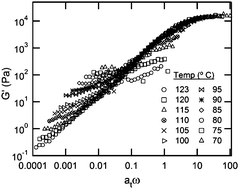The mechanical response of rod-coil block copolymers is critical to their processing and application in organic electronic devices and biotechnology. Using the weakly-segregated system poly(2,5-di(2′-ethylhexyloxy)-1,4-phenylenevinylene-b-isoprene) (PPV-b-PI), the shear behavior of a rod-coil block copolymer system was probed as a function of coil fraction to understand its flow behavior and to identify rheological signatures of phase transitions in this system. The rheology of the block copolymers of symmetric compositions showed behavior that was dominated by the relaxation processes of the rod homopolymer on short timescales, while on longer timescales they show non-terminal behavior with plateaus in both G′ and G″ indicative of a solid-like state. Disordering of the block copolymer at higher temperatures is accompanied by a failure of time-temperature superposition due to the disappearance of the solid-like interactions at long timescales and changes in the PPV relaxation modes at short timescales. As the strength of segregation and rod-rod ordering become weaker with increasing coil fraction, these signatures of the changes in microstructure with temperature disappear. When the coil block length is significantly longer than the entanglement molecular weight, signatures of both PI entanglement and the rod dynamics become apparent in the rheological behavior. Examination of isochronal temperature sweeps shows that the PPV crystallization transition is easily observed in symmetric block copolymers, but becomes difficult to detect at high coil fractions. The order-disorder transition (ODT) was not clearly observable as a mechanical signature in temperature sweeps. The failure of time-temperature superposition and the use of Han plots suggest that rheology may be useful to identify the ODT in rod-coil block copolymers only below some critical coil fraction.

You have access to this article
 Please wait while we load your content...
Something went wrong. Try again?
Please wait while we load your content...
Something went wrong. Try again?


 Please wait while we load your content...
Please wait while we load your content...